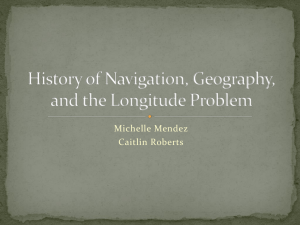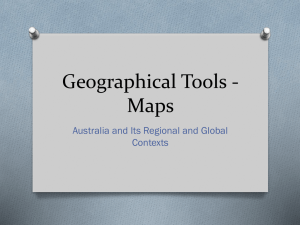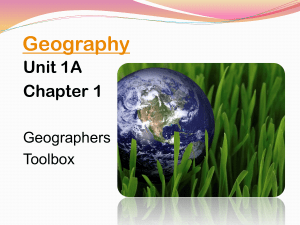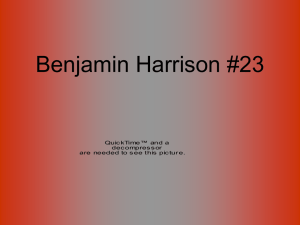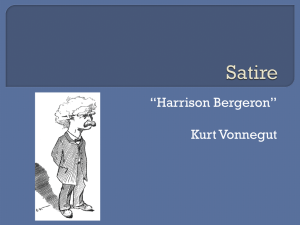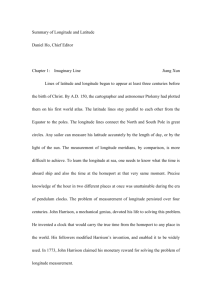Longitude Question
advertisement
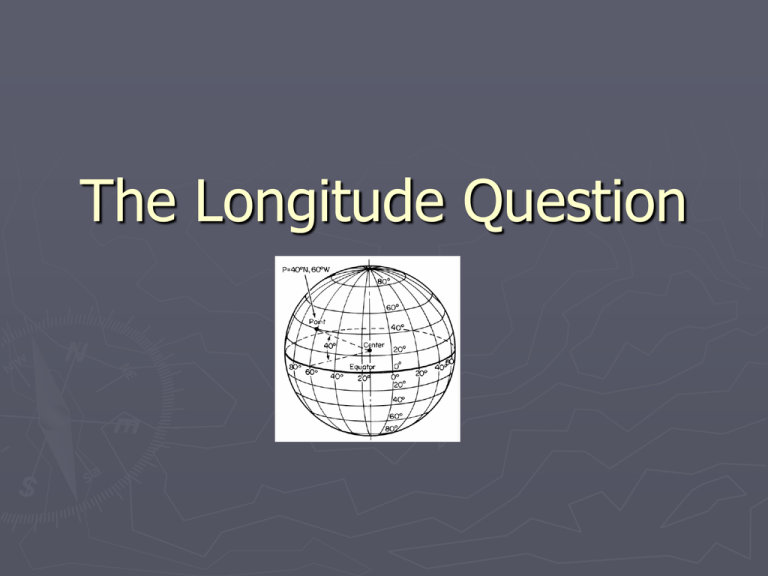
The Longitude Question 1490-1945 ► European exploration and colonial expansion is at its height ► British maintain worldwide dominance ► British Royal Navy dominates the seas Lands at any time part of the Brittish Empire shown in red. http://www.regiments.org/nations/ Latitude is easily determined by looking at the sun’s angle at noon. Using a sextant, navigators could precisely measure the angle of the sun above the horizon at local high noon. This angle could be used to determine ones latitude. http://en.wikipedia.org/wiki/Sextant The sextant could also be used to take lunar measurements to find longitude but the calculations were too difficult for most to perform. During cloudy days and nights, looking to the “heavens” for guidance was fruitless. Sailing for a few days in cloudy weather degraded information about the ship’s position. Land sightings, current, and weather changes were used to guide ships. Galileo’s method of using the location of Jupiter’s moons was impossible if the ship pitched and rolled. In 1707, five British ships sink within minutes after running onto the rocks of the Scilly Isles ► 1647 sailors die ► Multiple treasure chests of great monetary value lost. Scilly Isles Wreck was due to the difficulty of determining longitude at sea ►A sailor and unofficial navigator on board warned Admiral Shovell of the ships’ proximity to the Scilly Isles. ► For questioning the Admiral the sailor was hanged, according to some reports. Sir Clowdisley Shovell Admiral of the Association http://www.geocities.com In 1714 the British government passes the Longitude Act which: ► Offers a prize of £ 20,000 to anyone who can come up with a solution to find longitude at sea within ½ degree (35 miles at the equator). ► Creates a Longitude Board to evaluate solutions. ► The Longitude Board is comprised primarily of astronomers and mathematicians. John Harrison Clock Maker Extraordinaire ► ► ► ► ► Son of a Carpenter No formal education Carpenter and Mechanic by trade Keen understanding of materials, i.e. metals and woods Interested in creating a chronometer to solve the longitude problem. https://eee.uci.edu Early Achievements of Harrison ► Built a clock entirely out of wood at the age of 20. A self lubricating clock, where lubricants bleed out of the woods. ► Invented the Gridiron Pendulum. This was a pendulum constructed of alternating dissimilar metals. The thermal expansions of the two metals cancelled out, thus maintaining a constant pendulum length. Brass and Iron Rods http://physics.kenyon.edu/ What is a chronometer? ►A precision time piece that keeps the time at a fixed location. This time acts as a reference point for determining longitude. ► Knowing local noon at sea and the time at Greenwich England, navigators could determine how many minutes or miles they were from Greenwich, England. Chronometers had to keep time even when the ship tipped, pitched and yawed. 1810 Chronometer mounted on Gimbels http://www.stedmundsbury.gov.uk Precision Pendulum Clocks failed at Sea ► Accurate time is kept by the oscillations of the pendulum. ► Frequency (cycles/sec) are determined by the length of the pendulum and force of gravity ► f = (1/2p) * √(g/L) ► Pendulum clocks require a constant gravitational force, in other wordsstable ground John Harrison’s H1 Completed when he was 42 Two independent Pendulums This took seven years for Harrison to build. (Courtesy National Maritime Museum, London) The Board doubts a mechanical instrument can solve the longitude problem ► Board demands a sea trial of H1 ► Board grants Harrison £ 500 to improve H1 ► Eventually Harrison develops a small timepiece, the H4 at the age of 68 The H4 Multiple trials ► H4 goes to Jamaica and measures longitude to within 2 miles. ► Board claims result was “luck” ► H4 goes for a second trial, and measures location of Barbados within 10 miles. ► Board awards Harrison £ 10,000 but demands more testing and detailed plans so that device can be reproduced by other clockmakers. Foul Play ► Nevil Maskelyne was appointed Astronomer Royal and sits on the Board Wikipedia of Longitude ► Maskelyne develops a less accurate solution (barely within the Longitude Act’s limits) based on the lunar distance method, which requires many calculations from viewing the moon against the stars. Conflict of Interest ► Maskelyne claims Harrison’s H4 is inaccurate and results are just luck. Royal Intervention ► King George III finally intervenes on Harrison’s behalf and has him “righted”. ► In 1773, when he was 80 years old, Harrison received £ 20,000 from Parliament for his achievements, but he never received the official award (which was never awarded to anyone). ► Harrison struggled with the Board for over 38 years. Timepieces Today ► Quartz clocks – use an electronic oscillator that is made from a quartz crystal. Accurate to 10 seconds/year. ► Atomic clocks – uses the resonant frequency of atoms. Accurate to 1ms/year Some sources: TV Movie - Longitude http://www.youtube.com/watch?v=ROz0-4ymuXQ You Tube – John Harrison His Clock and the Longitude Problem
